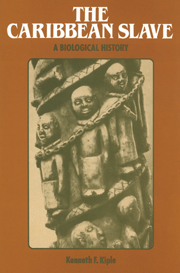Book contents
- Frontmatter
- Contents
- List of Tables
- Preface
- Acknowledgments
- Part I Background and Biology
- Part II Diet, Disease, and Demography
- Introduction
- 4 The Middle Passage and Malnutrition
- 5 Plantation Nutrition
- 6 Malnutrition: Morbidity and Mortality
- 7 Slave Demography
- 8 Slave Infant and Child Mortality
- 9 Black Diseases and White Medicine
- Part III Pathogens and Politics
- Notes
- Bibliographic Essay
- Index
9 - Black Diseases and White Medicine
Published online by Cambridge University Press: 19 October 2009
- Frontmatter
- Contents
- List of Tables
- Preface
- Acknowledgments
- Part I Background and Biology
- Part II Diet, Disease, and Demography
- Introduction
- 4 The Middle Passage and Malnutrition
- 5 Plantation Nutrition
- 6 Malnutrition: Morbidity and Mortality
- 7 Slave Demography
- 8 Slave Infant and Child Mortality
- 9 Black Diseases and White Medicine
- Part III Pathogens and Politics
- Notes
- Bibliographic Essay
- Index
Summary
The Negro can never feel the hardships of want. … In sickness he is provided with medical attention, and every attention and care is bestowed upon him which his situation requires.
Committee of the Legislature of Dominica (1823)Sorry am I that the subject requires me to say, that no part of Negro management has been more neglected, or erroneously performed than that which regards the treatment of the sick.
Dr. Robert Collins (1811)An interesting article, “Some Disease Patterns in West Indian Immigrants, ” was published in 1962 by a London physician. His purpose in writing was to warn colleagues that in treating these newcomers they were likely to “encounter some rather unusual disease patterns. ” Among the “new” illnesses general practitioners were told to be on the lookout for were “old” curses that had tormented the prospective patients' ancestors for centuries. Prominent among them were dysenteries, particularly amebic dysentery, and while schistosomiasis, filariasis, and other worm infections are also treated, the most remarkable aspect of the essay is that it can find so few “unusual disease patterns” to discuss. In fact, none of the illnesses that we saw decimating the slave young are mentioned, nor are leprosy, yaws, and other “exotic” ailments that tormented the slaves. It is not that these diseases have become extinct, and cannot be found in the Caribbean today. But most have become rare in the region, for infectious diseases as well as those of a frankly nutritional origin fade in the face of better nutrition.
- Type
- Chapter
- Information
- The Caribbean SlaveA Biological History, pp. 135 - 156Publisher: Cambridge University PressPrint publication year: 1985

